User Guide
1. Introduction
Welcome to PowerCards, a lightweight flashcard application that helps you streamline your learning process, enabling faster mastery of course materials through the use of flashcards (which we will simply refer as cards from now on). As a university student, you can capitalise on our powerful card management system and minimalist interface to create multiple decks of cards quickly to manage your course content and spend more time on learning instead.
This user guide will help you use PowerCards with ease and integrate it into your learning workflow in no time. It explains the key features of PowerCards and provides guidance on how to use them effectively to meet your specific learning needs.
- 1. Introduction
- 2. Quick Start
- 3. Features
- 4. FAQ
- 5. Command Summary
1.1. How to use the User Guide
- For a quick and easy way to get started with PowerCards, you can visit the Quick Start section.
- To understand the terms we use in PowerCards, you can visit the Key Terms section.
- To learn about the features that PowerCards provides and how to use them, you can visit the Features section.
- Having issues? Check out the FAQ section and see if you can find your solutions there!
💡 Tip:
- There’s a lot of information in this guide, so it’s a good idea to skim through the contents first. This will give you a better understanding on how PowerCards works. Then, you can dive into the sections that interest you the most.
- We hope this approach will make it easier for you to digest the content.
1.2. Key Terms
Deck
A deck refers to a collection of flashcards that are organized together based on a specific topic or subject. For example, you might create a deck of flashcards to study for a math test, with each card containing a different math problem and solution.
Card
A card refers to a flashcard within a deck. A card contains a question or prompt, and the corresponding answer or solution. During a review session, the card will only show the question, encouraging you to actively recall the answer. Once you attempt the question, you can command the card to reveal the answer and test your knowledge.
Tag
A tag refers to the level of difficulty (easy/medium/hard) you can assign to each card. It helps you prioritize your study time and focus on the flashcards that are more challenging or require more review. A card can only have at most one tag at any time.
1.3. User Interface Components
This section highlights the key components of PowerCards’ user interface. Refer to the description below for more information.
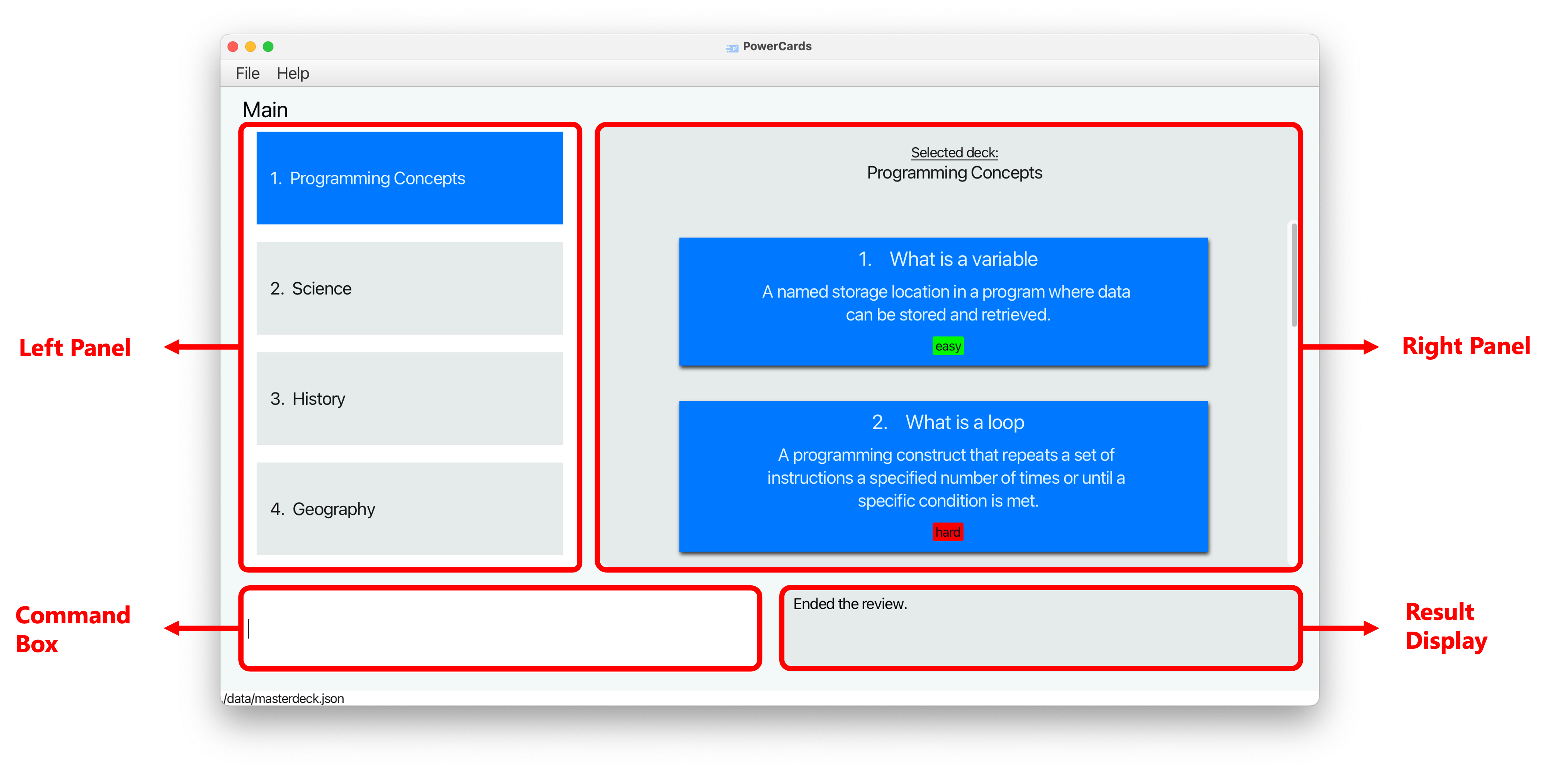
| Component | Description |
|---|---|
| Left Panel | This shows either a list of decks or the current review statistics depending on the mode you are in. |
| Right Panel | This shows either a list of cards or the current card in review depending on the mode you are in. |
| Command Box | This is where you enter your commands. |
| Result Display | This is where the results of your commands will be shown. |
2. Quick Start
-
Ensure you have Java
11or above installed in your Computer. If you don’t have it, you can download and install from this link. Remember to download the correct version for your Operating System! (e.g. Window or Mac) -
Download the latest
powercards.jarfrom here. -
Copy the file to the folder you want to use as the home folder for PowerCards.
-
Open a command terminal, enter the folder you put the jar file in using the
cdcommand, and use thejava -jar powercards.jarcommand to run the application.A GUI similar to the below should appear in a few seconds. Note how the app contains some sample data.

-
Type any command in the command box and press Enter to execute it. e.g. typing
helpand pressing Enter will open the help window. -
Refer to the Features below for details of each command.
3. Features
3.1. Command Components
This section explains some common components you may find in a command.
| Component | Example | Usage |
|---|---|---|
| Parameter |
QUESTION, ANSWER
|
Parameters are placeholders where you have to insert your input. Suppose add q\QUESTION a\ANSWER is a valid command to add a card. You can simply replace QUESTION and ANSWER with the question and answer of your choice. |
| Prefix |
q\ , a\ , t\
|
Prefixes are used to identify the parameters of a command. For example, prefix q\ identifies the parameter QUESTION in the command add q\QUESTION. |
| Optional Component | [t\TAG] |
Optional components can be omitted in certain commands. For example, add q\QUESTION a\QUESTION [t\TAG] is a valid command to add a card.The first two components q\QUESTION, a\ANSWER are compulsory. The last component t\TAG is optional. |
| Multi-value Parameter | KEYWORDS... |
These are parameters that can appear multiple times. For example, the command findCards KEYWORD... filters all the cards based on the keywords specified.This means that the parameter KEYWORD can:- Appear one time: findCards cell- Appear multiple times: findCards cell biology
|
| Index | INDEX |
Index refers to the index of the card/deck you want to target from the list. The index must be a positive number (1, 2, 3…). For example, deleteDeck 1 deletes the first deck in the deck list. |
| Flag |
-e, -m, -h
|
Flags are used to toggle a particular setting or behavior. For example, review 1 -e lets you review questions in the first deck that are tagged as easy only. |
![]() Notes about the command format:
Notes about the command format:
- If a parameter is expected only once in the command, but you specified it multiple times, only the last occurrence of the parameter will be considered.
e.g. if you specify
q\What is photosynthesis q\What is a cell, onlyq\What is a cellwill be considered. - Extraneous parameters succeeding commands that do not take in parameters (such as
help,list,exitandclear) will be ignored. e.g. if the command specified ishelp 123, it will be interpreted ashelp.
3.2. Main Mode
Welcome to the Main Mode of the PowerCards application! This is the default mode you will see when you open the app.
In the Main Mode, you can quickly and easily create new decks, add new cards to your decks, delete and modify existing cards or decks as needed, and more!
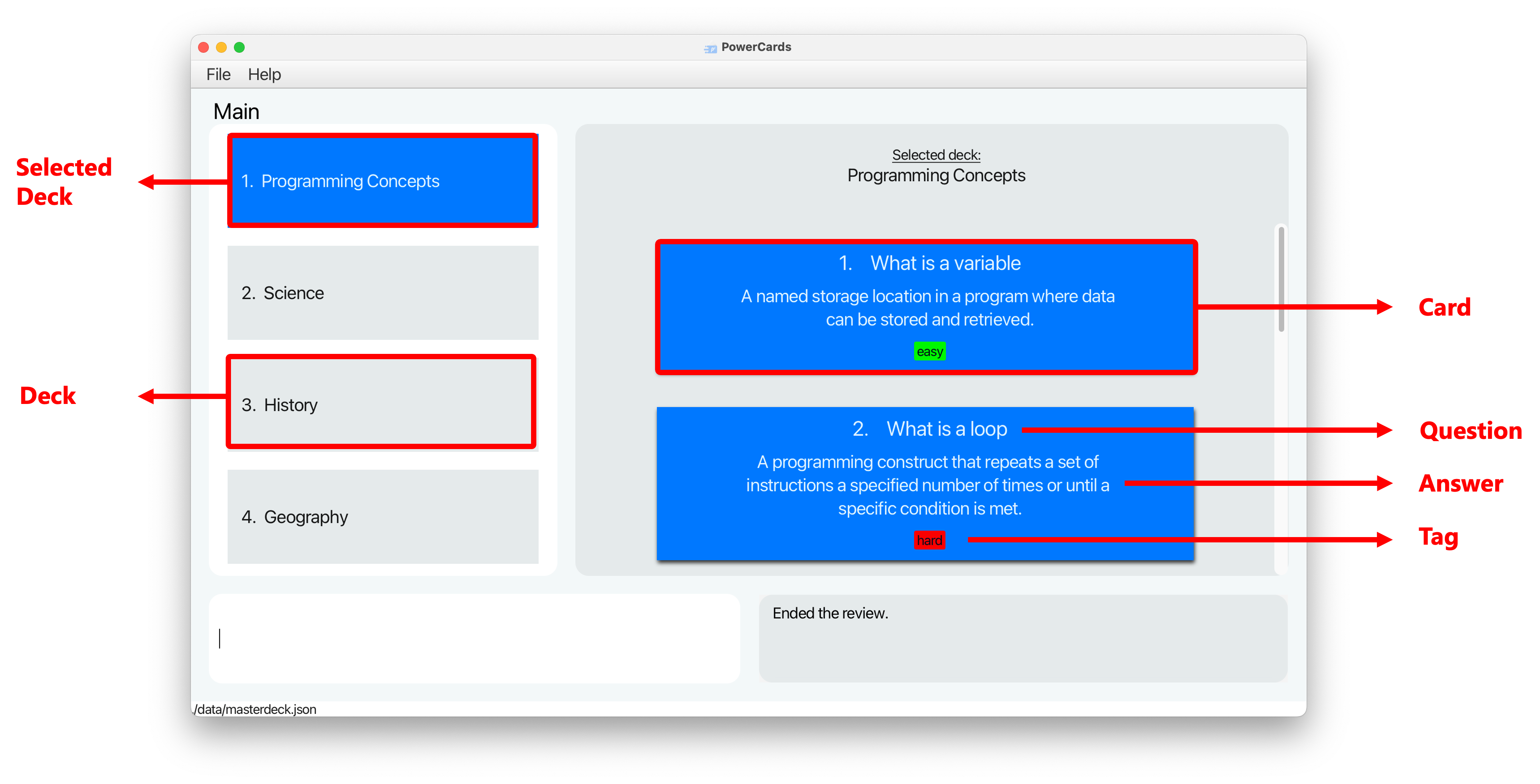
| Component | Description |
|---|---|
| Deck | A deck contains a list of cards. The existing decks are displayed in the left panel. |
| Selected Deck | The deck currently selected. The cards in this deck are displayed in the right panel. |
| Card | A card contains a question, an answer and an optional difficulty tag. |
| Question | The question that you assign to the card. |
| Answer | The corresponding answer to the question. |
| Tag | The tag indicating the difficulty level of the card, based on your evaluation. Each card can only be tagged with at most 1 difficulty. |
3.3. Main Mode - Before Selecting a Deck
3.3.1. Adding a Deck : addDeck
Before you can add any cards, you must first create a deck. It’s super easy though, just use the simple command below to get started with your first deck!
Format: addDeck DECK_NAME
-
DECK_NAMEis the name of the deck you want to create.- Deck name is case-sensitive and cannot be duplicated, e.g., if you already have a deck named
Science, you cannot create another deck namedScience. However, you can create a deck namedSCIENCEsinceSCIENCEmay be an acronym. - You do not need any prefix before deck name.
- Deck name is case-sensitive and cannot be duplicated, e.g., if you already have a deck named
Example:
-
addDeck Sciencewill create a deck titled Science. -
addDeck Mathwill create a deck titled Math.
3.3.2. Editing a Deck : editDeck
You just created a deck, but you realised you made a typo! Fret not, you can easily edit the name of the deck with this command.
Don’t worry! Editing a deck name will not affect the cards stored inside it.
Format: editDeck INDEX DECK_NAME
-
INDEXis the index of the deck you want to edit. - The deck’s index can be found in the displayed deck list.
-
DECK_NAMEis the new name you want to assign to the specified deck. - The new deck name must not match any existing deck names (Deck names are case-sensitive).
editDeck -1 will result in an error message on the result display as -1 is an invalid index.
Example:
-
editDeck 1 Chemistrywill edit the name of the first deck in the deck list to “Chemistry”. -
editDeck 2 Mathwill edit the name of the second deck in the deck list to “Math”.
3.3.3. Deleting a Deck : deleteDeck
Once you have no use for a deck, you can delete the deck and all the cards within it with this command.
Format: deleteDeck INDEX
-
INDEXis the index of the deck in the deck list. - The deck’s index can be found in the displayed deck list.
- Be careful, a deck (and cards within the deck) once deleted cannot be retrieved! - Make sure that the index you are providing is valid! For example,
deleteDeck -1 will result in an error message on the result display as -1 is an invalid index.
Example:
-
deleteDeck 1deletes the deck at index 1 and all the cards in that deck.
3.3.4. Finding Decks by Keywords: findDecks
If you’re looking for a way to quickly find a specific deck among the many you’ve created, you can use a handy command to filter your decks based on their names. Give it a try!
Format: findDecks KEYWORD...
- You can include multiple KEYWORDS - as long as a deck’s name contains at least one keyword, the deck will be found.
- At least one KEYWORD must be given.
- This command does not support partial words, e.g.,
findDecks programwill not return the same list of decks asfindDecks programming, despiteprogrambeing a partial word ofprogramming. - Keywords are case-insensitive.
findDecks programmingandfindDecks PROGRAMMINGwill return the same filtered decks. - Deck names matching at least one keyword will be returned (i.e.
ORsearch).
Example:
-
findDecks science programmingfilters decks whose names match keywordsscienceorprogramming. Below is the application display right after this command is executed.

💡 Tip:
- Notice there is a small text box
Finding Decks with keyword(s): science programmingbelow the filtered list of decks. This text box is displayed as long as the decks are filtered. It is to help you remember what you have previously searched for! - Notice that the result display will also show how many decks have been listed.
3.3.5. Showing all Decks : showDecks
After you filtered the decks using findDecks, you can see all the existing decks again using this command.
Format: showDecks
3.3.6. Selecting a Deck : selectDeck
Once a deck has been created, you can access the list of cards inside it with this command. Refer to the Main Mode - After Selecting a Deck section to find out what commands you can run with a deck selected!
💡 Tip:
- A deck can be selected and accessed anytime as long as you are in the Main Mode.
- This means you can switch to different deck while already selecting another deck!
Format: selectDeck INDEX
-
INDEXis the index of the deck in the deck list.
Examples:
-
selectDeck 2will select the deck at index 2.- The cards in this deck (if exist) will be displayed on the right panel.
3.3.7. Clearing the data : clear
Perhaps you want to start over and create new sets of decks and cards. This command clears all the existing decks and their associated cards from the application database.
Format: clear
-
Upon executing the command, a pop-up alert will appear and request you to confirm your decision.
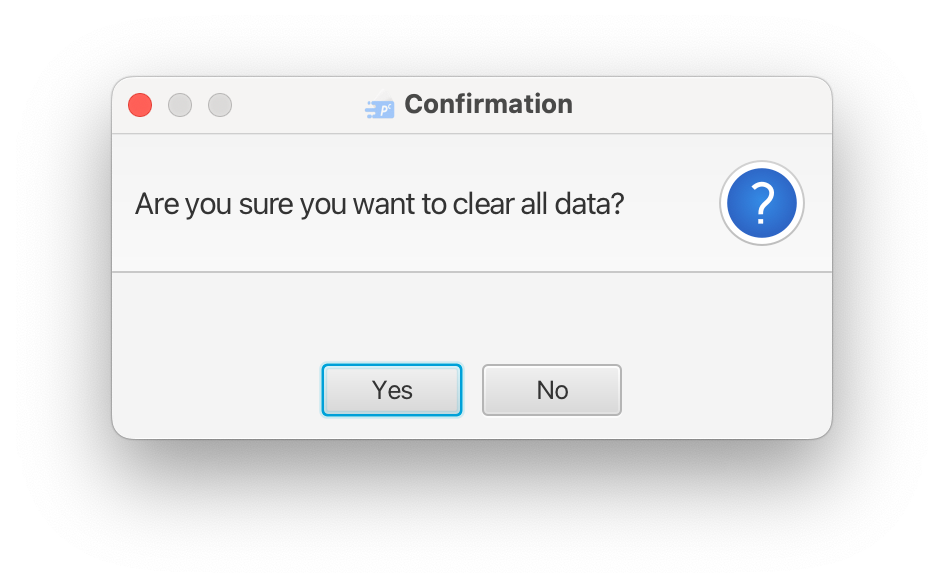
-
Selecting
Yeswill clear all data.
3.4. Main Mode - After Selecting a Deck
With a deck selected, you can see all the cards in the deck on the right panel! Now you can interact with the cards in the selected deck.
![]() Note:
Note that you will not be able to make any deck-related changes (e.g.
Note:
Note that you will not be able to make any deck-related changes (e.g. addDeck, deleteDeck) until you unselect the current deck.
3.4.1. Adding a Card: addCard
This command allows you to add a card to the selected deck.
Remember, every card needs to have a question and an answer, and it can have a maximum of one difficulty tag.
Format: addCard q\QUESTION a\ANSWER [t\TAG]
-
QUESTIONfield of the card is case-sensitive and cannot be duplicated in the same deck.- For example, if you already have a card with question
What is a loopin the deck, you cannot create another card in the same deck with questionWhat is a loop. - However, you can create another card with question
What is a LOOPsinceLOOPmay be an acronym.
- For example, if you already have a card with question
- The same
QUESTIONmay exist in multiple decks, i.e., a card can belong to multiple decks.
💡 Tip:
- A tag can only be of value Easy, Medium, or Hard.
- Tags are case-insensitive (
easyandEASYare treated the same).
Examples:
-
addCard q\What is chemical symbol for Oxygen? a\Oadds an untagged card with the given question and answer to the deck. -
addCard q\What is gravity? a\A force of attraction between objects due to their mass t\Easyadds a card tagged as “easy” with the given question and answer to the deck.
3.4.2. Deleting a Card : deleteCard
You can swiftly delete an existing card from the current selected deck with this command.
Format: deleteCard INDEX
-
INDEXis the index of the card in the card list on the right panel. - The card’s index can be found in the displayed card list.
deleteCard -1 will result in an error message on the result display as -1 is an invalid index.
- Deletes the card at the specified
INDEX. The card’s index can be found in the displayed card list.
Example:
-
deleteCard 2will delete the 2nd card in the deck.
3.4.3. Editing a Card : editCard
If you made mistakes while creating a card, no problem! You can easily edit any existing card using this command.
Format: editCard INDEX [q\QUESTION] [a\ANSWER] [t\TAG]
- Edits the card at the specified
INDEX. The card’s index can be found in the displayed card list. - At least one of the optional components must be provided.
- Existing values of the card will be replaced by the input values.
- If the same prefix appears multiple times, only the last occurrence of the prefix will be considered.
deleteCard -1 will result in an error message on the result display as -1 is an invalid index.
Examples:
-
editCard 1 q\What is chemical symbol for Carbon? a\Cedits the question and answer of the 1st card to beWhat is chemical symbol for Carbon?andCrespectively. -
edit 2 q\What is a recursion?will only edit the question of the 2nd card toWhat is a recursion?. The other fields of the card (answer, tag) remain unchanged. -
edit 3 q\What is a recursion? q\What is a loop?edits the question of the 3rd card to beWhat is a loop?.
3.4.4. Finding Cards by Keywords in Question : findCards
This command allows you to find specific cards you want to interact with based on the keyword(s) you enter.
It shows all the cards in the selected deck whose questions contain any of the given keyword(s).
You may interact with the filtered cards using their new indices, through commands such as editCard and deleteCard.
Format: findCards KEYWORD...
- You can include multiple KEYWORDS - as long as a card’s question contains at least one keyword, the card will be found.
- At least one KEYWORD must be given.
- Keywords are case-insensitive.
findCards whatandfindCards WHATwill return the same filtered cards. - Question field of cards matching at least one keyword will be returned (i.e.
ORsearch). - This command does not support partial words, e.g.,
findCards partiaandfindCards partialwill not return the same result despite “partia” being a partial word of “partial”.
findCards loop will not return a Card with question What is a loop?. For this example, you should search findCards loop? instead.Example:
-
findCards recursion loopshows all the cards whose questions match the keywordsrecursionorloop.
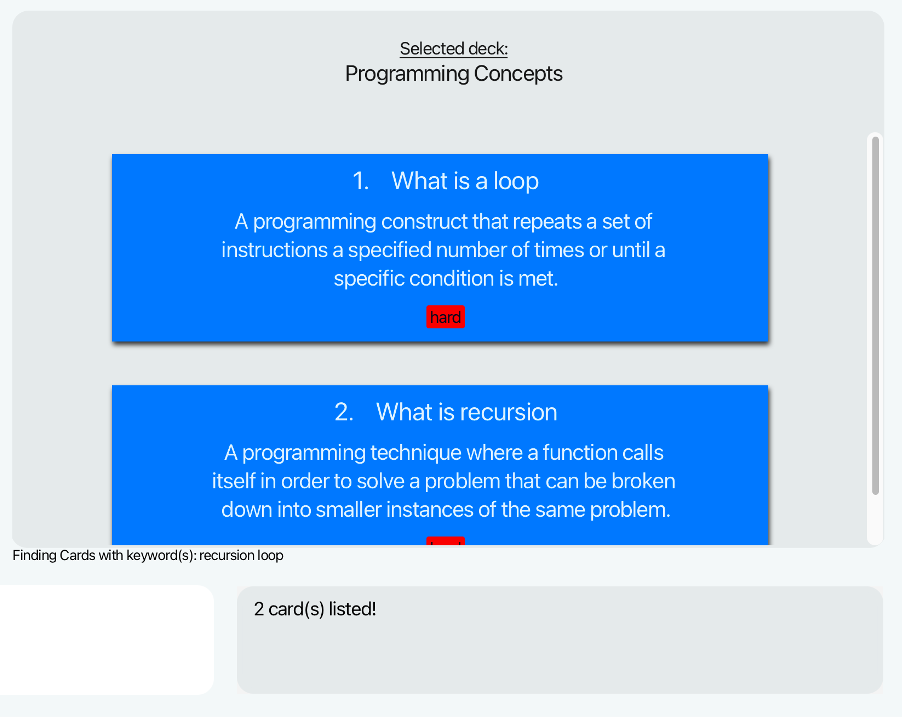
💡 Tip:
- There is a small text box
Finding Cards with keyword(s): recusion loopbelow the filtered list of cards. It remains on display as long as the cards are filtered. This is to help you remember what keywords you are searching for! - The result display will show how many cards matching the keywords have been found.
3.4.5. Showing all Cards : showCards
After you filtered the cards using findCards, you can see all the cards in the selected deck again using this command.
Format: showCards
3.4.6. Unselecting a Deck : unselectDeck
If you want to make deck-related changes, you must first unselect the current deck you are in. Refer to the Main Mode - Before Selecting a Deck section to find out what commands you can run without a deck selected!
This command allows you to unselect the currently selected deck.
Format: unselectDeck
- Upon unselecting a deck, you can no longer see the cards inside that deck.
3.5. Before entering Review Mode
3.5.1. Setting the Limit of Cards per Review: setLimit
If you’ve got a long deck of cards but only want to test yourself on a certain number of them during a review session, no problem! You can use a handy function to set an upper limit on the number of cards you’ll be reviewing. While the limit is in effect, the deck will be truncated to the specified number of cards. Give it a try!
You can set the limit back to ‘none’ to view all cards in the deck for future reviews.
Format: setLimit LIMIT_NUM or setLimit none
-
LIMIT_NUMmust be a whole number between 1 and 2147483647 inclusive. - If
LIMIT_NUMis greater than the number of cards inside the deck to be reviewed, you will review all the cards in that deck.
Examples:
setLimit 30setLimit none
3.6. Review Mode
Once ready, you can enter the Review Mode to test yourself on the cards of a deck. You can also specify the difficulties of the cards of the deck you want to test, e.g., you just want test medium and hard cards only.

In the review mode, you will see:
- On the left panel - the updated statistics of the current review (current deck, current card number, number of cards tagged each difficulty) and a navigation guide of the keys.
- On the right panel - the card that is currently under review, which you can flip to reveal the answer and then tag with a given difficulty.
To review a card, you can attempt the question on the card (in your mind or on a paper if you prefer!) before flipping it.
Flipping a card reveals the answer - based on how close your guess was to the answer or how confident you were when attempting, you can then tag the card with a difficulty of easy, medium or hard.
Your goal would be to eventually have all cards in a deck be tagged as easy!
3.6.1. Starting a Review: review
From the Main Mode, run this command to enter the Review Mode!
Format: review INDEX [-e] [-m] [-h]
- Reviews the cards from the deck with the specified INDEX. The deck’s index can be found in the displayed deck list.
-
-einclude this flag to test cards tagged as “easy” -
-minclude this flag to test cards tagged as “medium” -
-hinclude this flag to test cards tagged as “hard” - Omit any flags to test all cards in the deck
-
Examples:
-
review 5 -e -hlets you review all the cards tagged as “easy” or “hard” in the 5th deck. -
review 2lets you review all the cards in the 2nd deck.
3.6.2. Ending the Review: endReview
Ends the review and returns to the main mode. You can use this when you reach the end of the review deck or at any point during the review.
Format: endReview
3.6.3. Review Command Keys
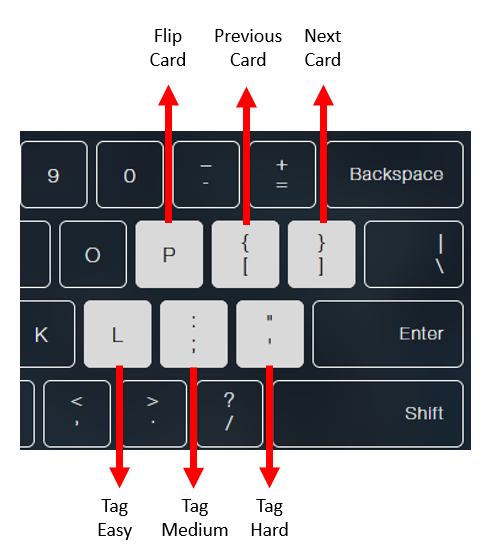
The diagram above shows the commands you will use to interact with the cards during a Review.
You must press the Enter key after typing in the command to execute it, e.g., pressing the key p alone will not flip the card.
Notice that the keys are all close to the Enter key so that you can breeze through decks of cards ergonomically!
- The top row of keys are commands to flip cards or move to the previous/next cards.
- The bottom row of keys are commands to tag the difficulty of the current card.
3.6.4. Flipping the Card: p
Flips the card to reveal or hide the answer.
Format: p
-
pis case-insensitive (Pis also a valid command).
3.6.5. Next Card: ]
Displays the next card. After reviewing the current card, you use this command to move on to the next card.
![]() Note:
If the card you are currently reviewing is the last card, the result display will display
Note:
If the card you are currently reviewing is the last card, the result display will display This is the last card. when you use this command.
Format: ]
3.6.6. Previous Card: [
Displays the previous card. Useful if you want to amend the tag of the previous card!
![]() Note:
If the card you are currently reviewing is the first card, the result display will display
Note:
If the card you are currently reviewing is the first card, the result display will display This is the first card. when you use this command.
Format: [
3.6.7. Tagging the Card as Easy: l
Tags the current card as easy. This replaces any previous tags.
Format: l
-
lis case-insensitive (Lis also a valid command).
3.6.8. Tagging the Card as Medium: ;
Tags the current card as medium. This replaces any previous tags.
Format: ;
3.6.9. Tagging the Card as Hard: '
Tags the current card as hard. This replaces any previous tags.
Format: '
3.7. Other Features
3.7.1. Viewing Help : help
If you are unsure about how to use PowerCards, you can always execute this command. This command creates a pop-up with a link to this User Guide, where you can access clear and concise instructions for each command and features of the app.
Format: help
3.7.2. Exiting the Program : exit
At any point, run this command to exit the program.
Format: exit
3.7.3. Saving the Data
PowerCards’ data is saved in the hard disk automatically after any command that changes the data. There is no need to save manually.
3.7.4. Editing the Data File
PowerCards’ data is saved as a JSON file [JAR file location]/data/masterdeck.json. Advanced users are welcome to update data directly by editing that data file.
💡 Tip: Not sure what a JSON file is? Check out this brief introduction to learn more!
![]() Caution:
Caution:
- If your changes to the data file make its format invalid, PowerCards will start with an empty data file on the next run.
- Do not type in any command as this will overwrite and discard your previous data! Simply close the application manually and edit the data file again until it is in valid format.
4. FAQ
Q: Will my data be automatically saved?
A: Yes, PowerCards automatically saves your data after every command entered.
Q: Where is my data saved?
A: If you have run PowerCards at least once, there will be a folder named data inside the folder you store the application. The save data can be found as masterdeck.json in the data folder.
Q: How do I transfer my data to another Computer?
A: First, make a copy of the JSON data file (can be found in [JAR file location]/data/masterdeck.json). Next, transfer the copy of data to the respective location of the other computer ([JAR file location]/data/masterdeck.json), overwriting any old data files. If done correctly, when you start the app on the other computer, you will observe that the data has been transferred over successfully!
Q: Can I rename my saved data file?
A: No, PowerCards currently only supports the use of masterdeck.json as the name of the saved data file.
Q: How can I verify if my answer is correct?
A: PowerCards operates on a self-testing basis. You can check your answer by writing it down before flipping the card to verify if you got it right or wrong.
Q: Can I have two cards with the same question?
A: No, if the two cards are in the same deck. QUESTION field of Card is case-sensitive and cannot be duplicated within the same deck. However, two cards with the same question can exist if they belong to different decks.
Q: Can I have two decks with the same name?
A: No. The name of the deck is case-sensitive and cannot be duplicated, e.g., if you already have a deck named Science, you cannot create another deck named Science. However, you can create a deck named SCIENCE since SCIENCE may be an acronym.
Q: What if I would like to include the prefix within my card (question or answer) or deck name? (For example addCard q\What is q\a a\It means q slash a should add a card with question What is q\a instead of a)
A: At the moment we do not support that. However, we plan to support this feature in the next iteration. We also like to point out that this is the reason why we use backslash \ rather than forward slash / for this current iteration as backslash is less commonly use than forward slash.
——————————————————————————————————————–
5. Command Summary
5.1. Main Mode - before selecting a Deck
| Action | Format, Examples |
|---|---|
| Select Deck |
selectDeck INDEX e.g., selectDeck 2
|
| Add Deck |
addDeck DECK_NAME e.g., addDeck Science
|
| Edit Deck |
editDeck INDEX DECK_NAME e.g., editDeck 3 Physics
|
| Delete Deck | deleteDeck INDEX |
| Find Decks |
findDecks KEYWORDS... e.g., findDecks programming history
|
| Show All Decks | showDecks |
| Start Review | review INDEX |
| Set Limit |
setLimit LIMIT_NUM e.g., setLimit 30 or setLimit none
|
| Clear | clear |
| Help | help |
| Exit | exit |
5.2. Main Mode - after selecting a Deck
| Action | Format, Examples |
|---|---|
| Select Deck |
selectDeck INDEX e.g., selectDeck 2
|
| Unselect Deck | unselectDeck |
| Add Card |
addCard q\QUESTION a\ANSWER [t\TAG] e.g., addCard q\What is gravity? a\A force of attraction between objects due to their mass t\Easy
|
| Edit Card |
editCard INDEX [q\QUESTION] [a\ANSWER] [t\TAG] e.g., editCard 1 q\What is chemical symbol for Carbon? a\C t\Hard
|
| Delete Card | deleteCard INDEX |
| Find Cards | findCards KEYWORDS... |
| Show All Cards | showCards |
| Start Review | review INDEX |
| Set Limit |
setLimit LIMIT_NUM e.g., setLimit 30
|
| Help | help |
| Exit | exit |
5.3. Review mode
| Action | Format, Examples |
|---|---|
| End Review | endReview |
| Flip |
p or P
|
| Previous Card | [ |
| Next Card | ] |
| Tag Easy |
l or L
|
| Tag Medium | ; |
| Tag Hard | ' |
| Help | help |
| Exit | exit |